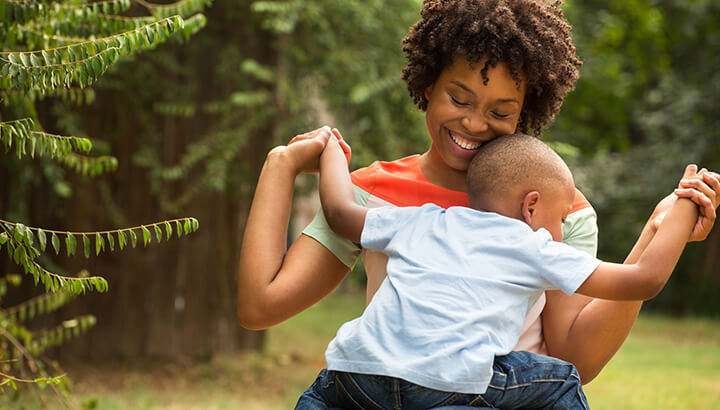
When my son was three years old, he frequently burst into tears over the most trivial of things. Potty training was the worst. There were a solid three months (maybe more, I blocked it out) where he did not want to use the bathroom by himself, and when I asked him to, he would absolutely freak out. Tears, screams and repeated shouts of “no.” Weeks and weeks of dreaded toddler meltdowns, which led to weeks and weeks of stress for my husband and I.
The mere mention of a toddler meltdown can send a shiver down virtually any parent’s spine. The toddler years are full of learning, discovery and super-cute moments… but they’re also full of meltdowns. Children under the age of three aren’t exactly the masters of emotional control (severe understatement, I know), and they let their parents hear about it — loud and clear.
Although they are a normal part of development, knowing this doesn’t exactly make dealing with toddler meltdowns any easier for parents. If you’re already stressed when they occur (often out of nowhere, while potty training or at the absence of a favorite shirt, hat, toy or pair of socks), you may find yourself crying on the floor with your toddler. That’s not exactly helpful for either of you.
While there’s nothing I can say to make dealing with toddler meltdowns “easier,” there is a way to get through them as calmly, peacefully and productively as possible: mindfulness. It takes some practice, but if you can get yourself into a mindful state when your toddler is melting down, you’ll come out on the other side with your sanity still intact. You’ll also be better able to help your child through whatever is bothering them.
I finally decided it was time to be mindful when the meltdowns were getting so bad that I would dread any aspect of potty training my son. I had practiced meditation in the past, and I knew it was now time to apply it to parenting. The stress was so bad that I knew I had to slow my mind down to get through this difficult time. I wasn’t great at it at first (that laying on the floor with my toddler crying thing happened), but with practice, I was able to stay calmer and the situation improved.
The following are a few steps to take to remain mindful during the kicking, screaming and tears of those terrible twos and threes.
Hit the ‘pause’ button
Wouldn’t it be nice if children came with a remote control, so that you could turn down the volume and hit “pause” as needed? Of course, they don’t, but you can still hit a metaphorical “pause” button when your little one is having a tantrum. When the meltdown begins, instead of panicking, imagine yourself “pausing” the situation, at least on your end.
Imagine your thoughts and feelings stopping for a moment. Resist. The. Urge. To. Freak. Out. Do not react. Simply take a moment and distance yourself from the situation at hand. Become an observer, not someone who is being screamed at. Remind yourself that this is normal and it shall pass.
Take five slow breaths

Now that you’re “on pause,” it’s time to breathe. It may be very difficult not to attend to your child’s meltdown right away, but trust me, if you take the time to relax and make yourself mindful first, you’ll get through it much more smoothly. Instead of reacting, take five slow, deep breaths. Actively observe each breath as it enters your nose and exits through your mouth. Feel the pause at the end of the breath. Don’t rush through this step.
Have a seat or lay down
After you pause and breathe for a moment, it’s time to mindfully get through this with your child. Sometimes, a change of state can be helpful. If you and your child are standing up, try to gently get them to sit down with you. If you’re already sitting, try laying down, or standing up and stretching.
When we change states, even just from sitting down to standing up, for example, we may experience the moment with fresh eyes. This may help your child to calm down more effectively.
If needed, leave the room
If the meltdown is really bad and you feel yourself losing control, you need to take a step back and collect yourself. If your child is safe in their room, tell them that you need a moment and will be right back, then walk out and close the door. Focus on your breath until you feel in control again, then re-enter. There may be screaming and banging on the door in the background, but if you need a moment to collect, it’s important to take it, lest you do something you regret, like yelling at your child.
I have had to do this on several occasions when my son was three. He was scream-crying, not able to hear anything I said, and I felt myself about to snap and start yelling. Rather than succumb, I realized it was better to exit the room for a moment. I stood outside his door, making myself breathe slowly. I repeated to myself that everything was okay and let my thoughts slow. Then, once I had lost the urge to scream, I re-entered the room and got through the rest of the meltdown.
If it is not safe for you to leave your child in their room for a moment (depending on the child’s age and the circumstances of the meltdown), wrap them up in a hug and simply be there with them. Go back to your “pause” state, and focus on your breath until you are collected. Often, all your child needs to get through a meltdown is just for you to be there with them and wait it out. This is much less taxing if you are mindful.
Teach your toddler to breathe
Once you’re through the hairiest part of the meltdown and your child has calmed down a little, you can breathe together. Teach your toddler to take slow, deep breaths with you. Show them how you do it and practice breathing together. The more you practice this with your child, the more they will do it on their own when they get upset. It’s never too early to start teaching mindfulness.
When my son gets stressed or upset, I tell him to take three slow, deep breaths. We do it together, and just those three breaths are very effective. Every time he starts to reach a fevered pitch, I remind him of those three slow, deep breaths. He’s gotten much better at calming himself down over time.
Talk it through

Once the meltdown is over (yay!), take a few moments to talk to your child about what happened. Give them a chance to tell them why they got upset, and listen thoroughly to their concerns. Oftentimes, it may have been something unavoidable, or arbitrary, but make sure that your child feels like they have been heard. Tell your toddler that it’s okay to be mad, but that it’s better to talk about things instead of yell.
This, of course, may not prevent a new meltdown from occurring very shortly, but with repetition (sometimes a lot of repetition), they’ll get the hang of calming themselves down. Don’t forget the hugs.
Consider regular meditation
If your child is at an age where they melt down frequently, and you’re having a hard time with it, consider adding regular meditation to your daily schedule. Just five minutes of meditation in the morning, and five minutes before bed, can help to center your mind and keep you feeling centered throughout the day. If you practice meditation regularly, when those meltdowns hit, you’ll already be in a mindful state, and will have a much easier time keeping things zen. Good luck!
— Tanya Mead

